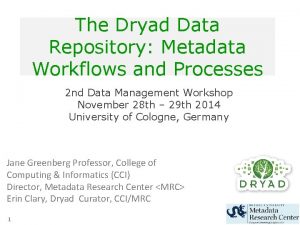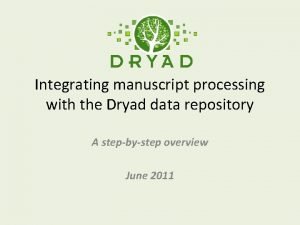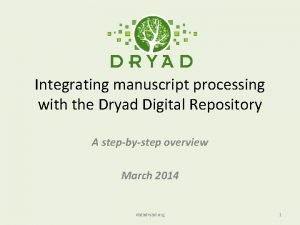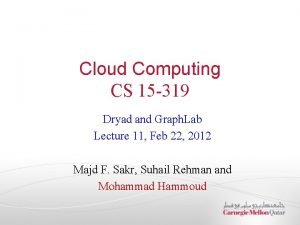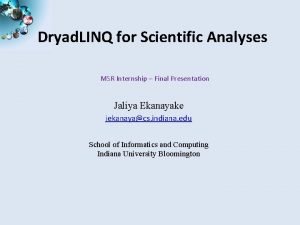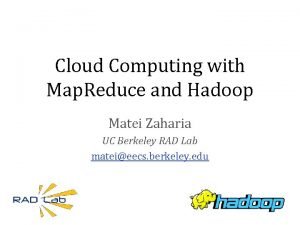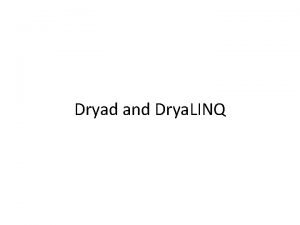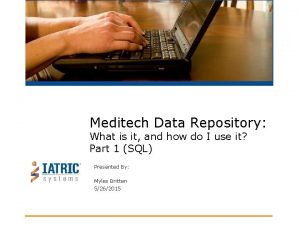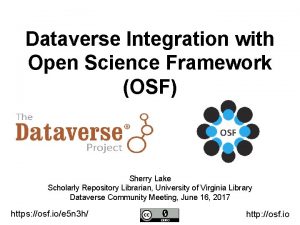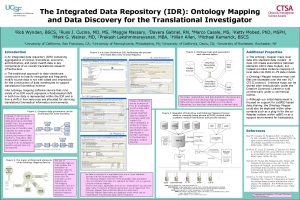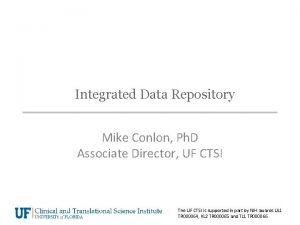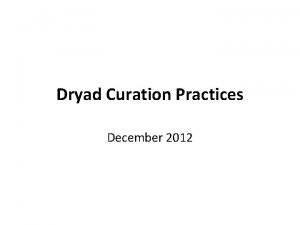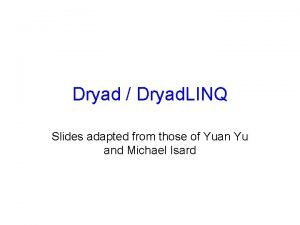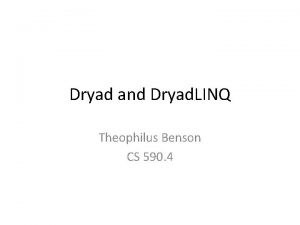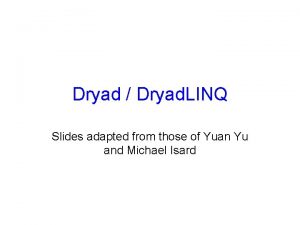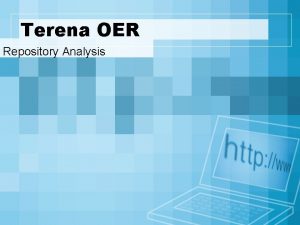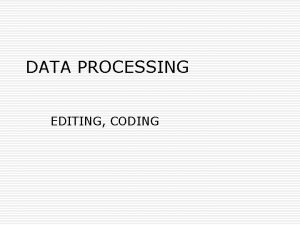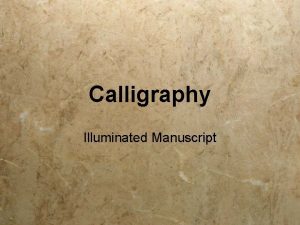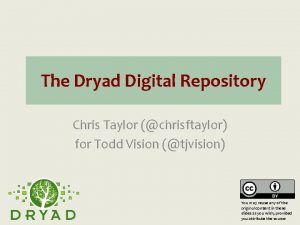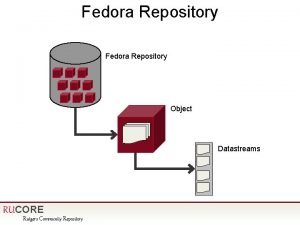Integrating manuscript processing with the Dryad data repository

















- Slides: 17

Integrating manuscript processing with the Dryad data repository A step-by-step overview June 2011

Submit manuscript Author submits manuscript to journal

Submit manuscript Manuscript metadata Journal sends… 1. notification to Dryad of new manuscript 2. request to author to upload data to Dryad, including URL with ms # Dryad creates provisional record for the manuscript, with authors, title, abstract, etc.

Sample email notice from an integrated journal to Dryad (at manuscript submission) Journal Name: Molecular Ecology Print ISSN: 0962 -1083 Online ISSN: 1365 -294 X Journal Admin Email: editorial. office@molecol. com Journal Editor: Tim Vines Journal Editor Email: managing. editor@molecol. com Article Status: in review MS Reference Number: XXXXX MS Title: Contrasting pattern of natural variation in global Drosophila melanogaster populations MS Authors: Nunes, Maria; Neumeier, Hannah; Schlötterer, Christian Contact Author: Maria Nunes Contact Author Email: (removed) Contact Author Address 1: (removed) Contact Author Address 2: Contact Author Address 3: Contact Author City: (removed) Contact Author State: Contact Author Country: (removed) Contact Author ZIP/Postal Code: (removed) Keywords: Molecular Evolution, Phylogeography, Population Dynamics, Population Genetics – Empirical Abstract: Despite the popularity of Drosophila melanogaster in functional and evolutionary genetics, the global pattern of natural variation has not yet been comprehensively described in this species. For the first time, we report a combined survey using neutral microsatellites and mitochondrial sequence variation jointly. Thirty-five populations originating from five continents were compared. In agreement with previous microsatellite studies, sub-Saharan African populations were the most variable ones. Consistent with previous reports of a single ‘out of Africa’ habitat expansion, we found that non-African populations contained a subset of the African alleles. The pattern of variation detected for the mitochondrial sequences differed substantially. The most divergent haplotypes were detected in the Mediterranean region while Africa harbored most haplotypes, which were all closely related. In the light of the well-established African origin of D. melanogaster, our results cast severe doubts about the suitability of mt. DNA for biogeographic inference in this model organism.

Sample email from journal to author encouraging data deposit & providing the Dryad URL Dear XXXXXX, Congratulations again on the acceptance of your manuscript, XXXXXX We would like to encourage you to deposit the data underlying this article in the Dryad Data Repository, http: //www. datadryad. org. As you may recall, we ask all authors to agree to make data available. This is a way to achieve that. Advantages of depositing data in Dryad include: * Visibility: Making your data available online (and linking it back to the publication) provides a new pathway for others to learn about your work through topical searches. * Citability: all data packages and data files you deposit will receive persistent, resolvable Digital Object Identifiers (DOIs) that can be used in a citation as well as listed on your CV. * Workload reduction: if you receive individual requests for data, you can simply direct them to the items in Dryad. * Preservation: your data files will be permanently and safely archived in perpetuity. * Impact: you will garner citations through the reuse of your data, and you can monitor the use of your data through Dryad's usage statistics The link below will take you to the Dryad record for your article, so you won't have to re-enter its bibliographic information, and can upload your files directly. More information about depositing data in Dryad is available at http: //www. datadryad. org/depositing. Please use the following link: EXAMPLE: http: //datadryad. org/submit? journal. ID=NNNN&manu=XXXXX (where NNNN is replaced by journal ID and XXXXX is replaced with a real manuscript number). Once you deposit your data package, it receives a unique and stable DOI identifier, which is immediately sent back to you and to the journal for inclusion in the published article. Depositing your data in good time for this to happen, is optimal; if the Dryad DOI doesn't appear in the final published article, that of course greatly weakens its connection to the underlying data.

Submit manuscript Submit data Submission notification Author submits data to Dryad, using the link sent by the journal to the provisional record

Submit manuscript Submit data Submission notification Peer review Review passcode Dryad sends reviewer passcode to journal, for dissemination to peer reviewers NOTE: this step only applies if the journal has chosen to make data available for the peer review process

Sample email notice from Dryad indicating reviewer access URL Dryad has received the following data package: Title: Data from: Contrasting pattern of natural variation in global Drosophila melanogaster populations Submitted by: Jane User (jane@someuniversity. edu) Data file(s): Microsatellite data Microsatellite Primers Dryad has assigned the following provisional DOI to the submission. This DOI may be included in the article manuscript. Although this DOI is not yet fully registered with the DOI system, it will be registered when the manuscript is accepted for publication. doi: 10. 5061/dryad. 123 abc Journal editors and anonymous peer reviewers may view the submission for review purposes using the following url: http: //datadryad. org/submission-review? wf. ID=517&token=d 8420534 -3477 -4986 -9366 -bb 17856 d 818 b Many thanks! The Dryad Team

Submit manuscript Submit data Submission notification Peer review Review passcode Acceptance notification Production Curation Dryad curator… 1. reviews & approves the data files 2. notifies journal and author of DOI Data DOI Upon final article acceptance, journal… 1. notifies Dryad 2. includes Dryad DOI in final article

Sample email notice from an integrated journal to Dryad (acceptance) Journal Name: Molecular Ecology Print ISSN: 0962 -1083 Online ISSN: 1365 -294 X Journal Admin Email: editorial. office@molecol. com Journal Editor: Tim Vines Journal Editor Email: managing. editor@molecol. com Article Status: accepted MS Reference Number: XXXXX MS Title: Contrasting pattern of natural variation in global Drosophila melanogaster populations MS Authors: Nunes, Maria; Neumeier, Hannah; Schlötterer, Christian Contact Author: Maria Nunes Contact Author Email: (removed) Contact Author Address 1: (removed) Contact Author Address 2: Contact Author Address 3: Contact Author City: (removed) Contact Author State: Contact Author Country: (removed) Contact Author ZIP/Postal Code: (removed) Keywords: Molecular Evolution, Phylogeography, Population Dynamics, Population Genetics – Empirical Abstract: Despite the popularity of Drosophila melanogaster in functional and evolutionary genetics, the global pattern of natural variation has not yet been comprehensively described in this species. For the first time, we report a combined survey using neutral microsatellites and mitochondrial sequence variation jointly. Thirty-five populations originating from five continents were compared. In agreement with previous microsatellite studies, sub-Saharan African populations were the most variable ones. Consistent with previous reports of a single ‘out of Africa’ habitat expansion, we found that non-African populations contained a subset of the African alleles. The pattern of variation detected for the mitochondrial sequences differed substantially. The most divergent haplotypes were detected in the Mediterranean region while Africa harbored most haplotypes, which were all closely related. In the light of the well-established African origin of D. melanogaster, our results cast severe doubts about the suitability of mt. DNA for biogeographic inference in this model organism.

Sample email notice Dryad indicating data package DOI Thank you for your recent submission to the Dryad repository titled "Data from: Contrasting pattern of natural variation in global Drosophila melanogaster populations". Your data package has been archived in Dryad and assigned a unique identifier, called a DOI. Including the data DOI in the published article will make readers aware that the data files are available, and enable their access and citation. The DOI may be presented as follows: Data deposited at Dryad: doi: 10. 5061/dryad. 123 abc Dryad links your data to your published article; it is up to authors and journals to link the published article to its supporting data. Please work with your journals editorial and production staff to ensure that the data DOI is included. Many journals specify a particular location for such links to data in repositories, or have a section on Data Accessibility. You can also provide your data DOI in the text, just before the References. If your article has already been published, use this DOI to refer others to your data. Please let us know if you have any questions or concerns. The Dryad Team

Submit manuscript Submit data Submission notification Peer review Review passcode Acceptance notification Production Curation Data DOI Data publication Article Publication Dryad publishes data files with link to article Journal article is published with link to data DOI

Submit manuscript Submit data Submission notification Peer review Review passcode Acceptance notification Production Curation Data DOI Data publication Article metadata Article Publication Curation At article publication, journal notifies Dryad of final bibliographic details

Submit manuscript Submit data Submission notification Peer review Review passcode Acceptance notification Production Curation Data DOI Article metadata Curation This may look complicated, but journals are only responsible for the three notifications circled in red, and the first is only required if the peer review process is used.

Submit manuscript Peer review Submit data Acceptance notification Curation Production Data DOI Article metadata Curation Simplified process (without peer review)

A recent example from a PLo. S ONE paper. Dryad reports the article DOI, and the article reports the Dryad DOI. This establishes a permanent reciprocal linkage between the article and its data. Article: Wu D, Wu M, Halpern A, Rusch DB, Yooseph S, Frazier M, Venter JC, Eisen JA (2011) Stalking the fourth domain in metagenomic data: searching for, discovering, and interpreting novel, deep branches in phylogenetic trees of phylogenetic marker genes. PLo. S ONE 6(3): e 18011. doi: 10. 1371/journal. pone. 0018011 Dryad data package: Wu D, Wu M, Halpern A, Rusch DB, Yooseph S, Frazier M, Venter JC, Eisen JA (2011) Data from: Stalking the fourth domain in metagenomic data: searching for, discovering, and interpreting novel, deep branches in phylogenetic trees of phylogenetic marker genes. Dryad Digital Repository. doi: 10. 5061/dryad. 8384

For more information… • Complete documentation & examples are on the Dryad wiki: https: //www. nescent. org/wg_dryad/Submission_Integration • Contact the Dryad team: – Ryan Scherle rscherle@nescent. org – Peggy Schaeffer pschaeffer@nescent. org
 Dryad data repository
Dryad data repository Dryad data repository
Dryad data repository Dryad digital repository
Dryad digital repository Dryad in cloud computing
Dryad in cloud computing Dryad microsoft
Dryad microsoft Dryad global internship
Dryad global internship Dryad microsoft
Dryad microsoft Dryad programming
Dryad programming Microsoft dryad
Microsoft dryad Meditech data repository
Meditech data repository Upper peninsula hospitals
Upper peninsula hospitals Clinical data repository
Clinical data repository Osf open science
Osf open science Integrated data repository
Integrated data repository Christiana mcmahon
Christiana mcmahon Integrated data repository
Integrated data repository Geothermal data systems
Geothermal data systems Medical manuscript writing
Medical manuscript writing
